What is erantis and how to grow it?

Erantis or, as they are also called, spring plants, in appearance, seem to be very gentle and thermophilic plants. But this is only at first glance. In fact, these flowers are resistant to low temperatures, and the flowering period coincides with the first melting of the snow. Erantis are successfully cultivated. They are not particularly demanding in care, but certain rules still need to be followed.


general description
Erantis (Eranthis) is a perennial plant belonging to the buttercup family... The name contains two root-forming words: er - spring and anthos - flower. Literally translated, it sounds like "spring flower". They differ in tuberous roots, the stem is short, rarely grows more than 15 cm. The leaves of spring plants are palm-like, located on long petioles. The inflorescences are not particularly large, reach 3 cm in diameter, are presented in white and yellow shades.
It is noteworthy that under the inflorescences there are specific green bracts. This feature gives the Erantis extraordinary beauty and decorative appearance. It is for this that the spring gardener is loved by the owners of personal plots and landscape designers.



Types and varieties
The genus includes only 7 species. In the wild, this plant is found in Europe and Asia. Each of the species has its own distinctive characteristics.
Winter
In England it is called aconite, and the south of France is considered the birthplace of this species. It is a cushion perennial, which is 4-5 cm wide and 5-8 cm high. The plant is frost-resistant, the inflorescences are cupped, up to 3-5 cm in diameter, painted in a bright yellow shade.
The flowering period is in late winter and early spring. Prefers alkaline soil, in which it grows rather quickly. Not afraid of abundant leaf fall, feels good under hazel trees.

Siberian
This perennial is found in Eastern and Western Siberia. Small white inflorescences appear only in May, and finish blooming in early June. But this is when it comes to growing in the northern regions. In the south and in central Russia, this period will begin somewhat earlier.

Cilician
Perennial, which reaches a height of 8 cm and a width of 5 cm.Most often found in Turkey and Afghanistan. Resistant to temperature extremes. The inflorescences are 3-4 cm in diameter, colored yellow. Its features are the presence of a large number of petals on each inflorescence, as well as relatively late flowering, which occurs in mid-March.

Star-shaped
Erantis of this species are most often found in the Far East. The inflorescences are not particularly large. The petals at the base are colored lilac, then gradually turn into white. The active flowering period begins in early April. It is noteworthy that the most common variety of this species is Sonata... It is well cultivated, looks good on flower beds, and is suitable for landscape decoration on a personal plot.


Long-legged
The homeland of this perennial is Central Asia. In all respects, it is very similar to the winter one. The only difference is that erantis from this species often grow in length much more than their congeners. This feature is clearly reflected in the name. Flowers are yellow.

Tubergen
This is a garden hybrid that was bred by crossing the Winter and Cilician Erantis.In terms of qualities, this is the same cushion perennial, which grows up to 8 cm. Of the whole genus, it is the most thermophilic. Inflorescences are yellow, up to 2-3 cm in diameter.

Peristoncutting
A cushion-shaped perennial, the height and width of which are 5 cm each. It is most often found in nature in Japan, prefers to grow in the limestone zone. Inflorescences are delicate, white, with a yellow-violet center.

Landing
Seed collection takes place in the spring. At the same time, they need to be sown. If this is not done, then you will have to carry out the stratification procedure, which consists of several stages.
- Any container needs to be filled with dry sand, and put the seeds of erantis there.
- For storage, the box is removed in the refrigerator. During the entire period of stratification, the seeds must be mixed periodically. And moisten the sand itself a little. This can be done with a spray bottle.
- In this state, the seeds should spend the whole winter, after which they can be planted.


For erantis, a not particularly sunny area is chosen, since the plant prefers to be in partial shade. Ice stagnation can damage the plant, so lowlands are not suitable for cultivation. Erantis prefers light, moist soil with a low alkali content. The seeds need to be deepened 5 cm into the prepared soil. Seedlings will appear in the same spring. A small stem is shown first, and then foliage.
After a while, the latter falls off, but you do not need to be afraid of this state, since this is a natural stage in the development of a plant. This is how it gains strength. Then new leaves grow, the plant becomes stronger. Stronger shoots can be expected next spring.
The distance between the bushes should be at least 8 cm. Erantises begin to bloom only in the third spring after planting.


Reproduction methods
After three years, the plant's root system begins to develop well. Tubers can be used for reproduction. Consistently, the process looks like this.
- The tuberous parts, together with the roots, are carefully removed from the soil. It is very important here not to damage the root system of the plant.
- Next, the root must be divided, while highlighting the youngest tubers.
- The cut site must be well disinfected using charcoal for this purpose.... If this is not done, then the plant will start to hurt.
- The separated roots must be planted in a new prepared place. The distance between plantings should be from 8 to 12 cm. It is permissible to plant up to 3 tubers in one hole. If you plant the tubers too often, then after a while you will have to transplant, since the plants will interfere with each other. It is noteworthy that it is allowed to plant erantises belonging to different varieties and types on the same flower bed.


Before planting, the wells themselves can be slightly moistened, and then additionally water the plantings with warm water... Humus and wood ash should be used as top dressing. There is also a seed propagation method. For its implementation, it is necessary to collect seeds, plant them, and then provide appropriate care. The plant does not require special care, since in the spring there is enough moisture in the soil without watering, and in the summer for the erantis there comes a period of relative dormancy. The only thing that should not be forgotten is loosening the soil. This completes the care of the plant in the open field. Almost all types of erantis calmly relate to low temperatures, so they do not need any shelter for the winter period.
During the first 5 years, you do not need to think about transplanting the Erantis to a new location. For 6-7 years after planting, the plant will need separation. To do this, you need to dig up the tubers, separate the youngest and healthiest from them, plant them in flower beds or other selected places. Attention! Erantis is a poisonous plant, so it is important not to plant it in places where pets are walking, as well as in the immediate vicinity of playgrounds. If after transplanting the plant takes on an unhealthy appearance, fertilization can be applied. The best option in this case would be slurry.
It must first be prepared, and then introduced under the root of each plant. This will give him the strength to restore his normal appearance, he will put in order the general condition of erantis.


Diseases and pests
Erantis is by nature a very poisonous flower, so it is not attacked by rodents and other pests.... Both the juice and the pulp of the plant pose a real danger to representatives of the animal world and insects. However, with improper care, erantis can get sick. Most often, the painful condition begins at the moment when the soil becomes excessively moist. Excess moisture negatively affects primarily the root system of the plant. In this state, it is actively covered with mold, which gradually passes from the roots to the stems, which destroys the flower. In order to prevent moisture stagnation, it is necessary to regularly monitor the soil moisture level. And so that the roots constantly have access to fresh air, it is recommended to loosen the soil.
From the description it is clear that erantis are relatively unpretentious plants. They do not require any special care, while they begin to bloom earlier than other ornamental crops. They are very often used to decorate personal plots. The photo gallery presents the most successful examples of the use of erantis in landscape design. Thanks to erantis, already at the end of winter or at the very beginning of spring, you can observe attractive yellow and white flowers on your site.










































































































The comment was sent successfully.